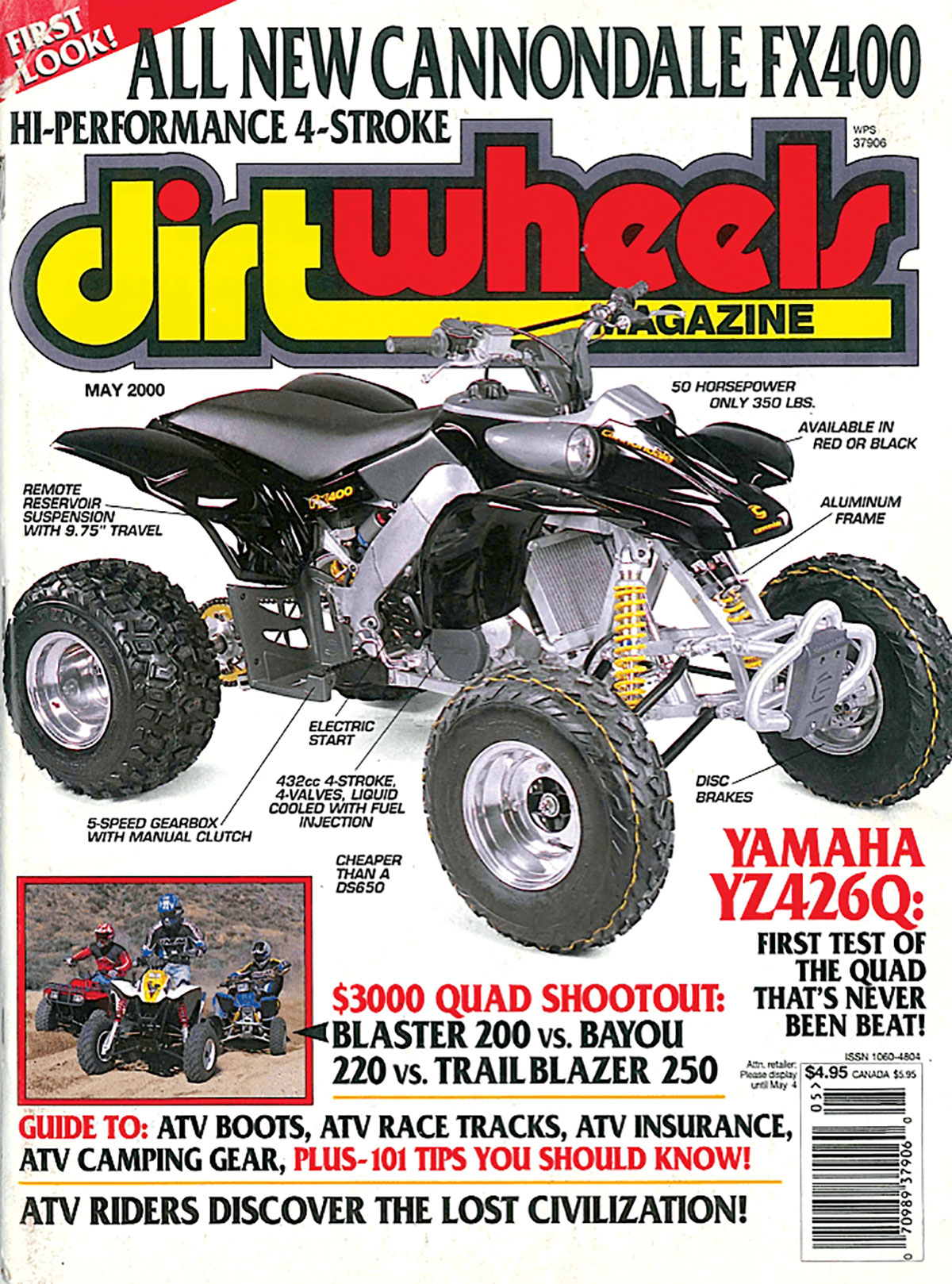CANNONDALE QUADS
History of America's revolutionary performance quad
— From the beginning until today —
By the staff of Dirt Wheels:

When it comes to fast street bikes, dirt bikes, ATVs and UTVs, the United States has always been the country to have sold the most machines. It was American riders and mechanics who developed and improved these machines; however, they were made somewhere else. This caused everyone to wonder, “Hey, how come there isn’t an American manufacturer building the high-performance vehicles we want?” Cannondale wondered about that, too, so they boldly set out to be that company, using the latest in American technology and ingenuity.
Cannondale made its fame from building mountain bikes here in the USA, and they were one of the top brands in the bicycling world. Around the late 1990s rumor had it that they were going to take their expertise into the dirt bike and ATV categories as well. We all applauded Cannondale and looked forward to finally having an American company build the kind of machines we were used to buying from Japan.

GETTING STARTED
The engineering and development of these high-tech dirt bikes and quads took longer than one might expect, based on so many new ideas being mixed into the design. After starting with a Folan engine, Cannondale decided to design their own. The single-cylinder engine was set to have four valves operated by dual overhead cams, which certainly wasn’t unusual for a high-revving performance engine, but Cannondale wanted to go strictly with fuel injection, which was uncommon for dirt bikes and quads. Another first was turning the head around to have the intake in front and the exhaust in the rear.

Along with new innovations in the engine, the frame being made of aluminum was another first for the off-road world too. Since Cannondale bicycles were known for their strong, lightweight aluminum frames, they naturally wanted to continue that philosophy with their motor vehicles as well. So, with all of the new things being molded together into one package, you can imagine the amount of engineering and testing that was required to make sure it all worked. Perhaps Cannondale underestimated the amount of time that would take, because it seems like their financial planning didn’t go far enough before payments on big loans were being called in.

There were investors and lenders who wanted money, and Cannondale had to rush their machines to production and to dealers to get some cash flow. The problem is that the dirt bikes and quads could have used a little more time to work some bugs out. The first arrival of the dirt bikes didn’t get glowing reviews because of handling and suspension issues. The FX400 quad, however, didn’t have those issues. Fast riders had no problem adapting to its turning and carving mannerisms, but the quad’s motor did experience some of the same durability problems that affected the dirt bike’s engine.

Cannondale was aware of these problems, and they seemed eager to keep their customers happy by offering recalls and free updates. No matter how much the company struggled to succeed, though, they just couldn’t overcome the money issue. The good news story of the decade came to an end in 2003 when Cannondale filed for bankruptcy. The Dirt Wheels crew was bummed, along with everyone else, that this dream was never able to fully materialize.

THE STORY CONTINUES
Okay, so what happened after bankruptcy? Well, the good news is that ATK bought the remaining inventory of Cannondale. ATK was a smaller-cottage motorcycle company putting dirt bikes together using other manufacturers’ engines. They became the source for any parts that the 8000 Cannondale owners might need. Not only that, but ATK pinpointed the reliability problems and offered update kits to cure them.

The original Cannondale 440 engines were known to vibrate, and ATK offered a new crankshaft that was better balanced and held together well. The original piston had a short lifespan, but the new ATK piston was stronger and lasted three times longer. The original gearbox had too big of a gap between fourth and fifth gears, and ATK offered new gears with closer spacing. The original clutch hub made a lot of noise, and ATK’s new one fixed that. ATK also sold new linkages to make the transmission shift smoother.

Many of the original Cannondale owners had complaints about hard starting and erratic throttle response at low revs. That was traced to the fuel injection, and ATK’s remapping of the ECU cured that problem.

It was the May 2000 issue of Dirt Wheels when the first Cannondale quad appeared on our cover, and it was a hot topic for only three years. Today, 18 years later, you may still occasionally see these machines out on the trail. The main reason why is that there are many enthusiasts who make it a point to keep this part of ATV history alive. It’s truly a hall-of-fame quad based on the significant contributions it made to ATV’s high-performance ideology. You can say it was the machine that sparked Yamaha and Honda to come out with their 450 quads, which triggered other manufacturers to do the same.

FOR MORE INFO
Don’t be gun-shy if you see a used Cannondale 440 quad for sale. Yes, it may require some more effort and money to bring up to par than a Japanese machine, but the resources are there to make it possible. For general information that Cannondale owners share, go to
www.cannondaleriders.com.
For Cannondale parts, accessories and an engine exchange program, a good place to check out is www.blackwidow-ok.com.
For Cannondale parts, owner’s manual, parts manual and service manual, go to http://atkusa.com/parts/atk-cannondale/.



Comments are closed, but trackbacks and pingbacks are open.